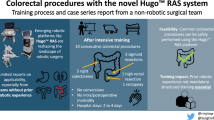Abstract
Minimally invasive esophagectomy (MIE) is technically challenging. Da Vinci Robotic system could improve surgical dissection with additional degree of freedom from robotic arms. This study aimed to assess the feasibility and safety of performing MIE using Da Vinci Robotic system among patients with esophageal cancers. From 2009 to 2013, consecutive patients with esophageal cancers who received robotic-assisted MIE were recruited. We excluded tumors with suspected invasion to adjacent organs. Preoperative staging included EUS, CT thorax and abdomen and bronchoscopy. We perform mobilization of thoracic esophagus with two-field lymphadenectomy using robotic system, followed by laparoscopic gastric mobilization and hand-sewn cervical esophagogastric anastomosis. A total of 20 patients were recruited (16 male and 4 female) with mean age of 64.2 ± 8.8 years. All patients were successfully treated with robotic-assisted MIE with mean operative time of 499.5 ± 70 min and blood loss of 355.7 ± 329.6 mls. There was no pulmonary complication, while three patients sustained anastomotic leakage and managed conservatively. The mean hospital stay was 13 ± 6 days. Five patients had stage I tumors, five had stage II, and nine had stage III disease. One patient had complete response after neoadjuvant chemoradiotherapy. The number of lymph node dissection was 18.2 ± 13.2, and 2.8 ± 5.7 nodes involved. The follow-up period was 21 ± 9 months, and the overall survival was 75 %. Robotic-assisted MIE is feasible and safe for treatment of esophageal cancers. The surgical dissection can be enhanced by improved ergonomics from robotic arms and sense of depth from 3D images.




Similar content being viewed by others
References
Brusselaers N, Mattsson F, Lagergren J (2014) Hospital and surgeon volume in relation to long-term survival after oesophagectomy: systematic review and meta-analysis. Gut 63(9):1393–1400
Tachibana M, Kinugasa S, Yoshimura H, Shibakita M, Tonomoto Y, Dhar DK, Nagasue N (2005) Clinical outcomes of extended esophagectomy with three field lymph node dissection for esophageal squamous cell carcinoma. Am J Surg 189:98–109
Hagen JA, DeMeester SR, Peters JH, Chandrasoma P, DeMeester TR (2001) Curative resection for esophageal adenocarcinoma: analysis of 100 En Bloc Esophagectomies. Ann Surg 234(4):520–531
Hulscher JB, van Sandick JW, De Boer AG, Wijnhoven BP, Tijssen JG, Fockens P, Stalmeier PF, Ten Kate FJ, van Dekken H, Obertop H, Tilanus HW, van Lanschot JJ (2002) Extended transthoracic resection compared with limited transhiatal resection for adenocarcinoma of the esophagus. N Engl J Med 347(21):1662–1669
Hulscher JB, Tijssen JG, Obertop H, van Lanschot JJ (2001) Transthoracic versus transhiatal resection for carcinoma of the esophagus: a meta-analysis. Ann Thorac Surg 72:306–313
Luketich JD, Pennathur A, Awais O, Levy RM, Keeley S, Shende M, Christie NA, Weksler B, Landreneau RJ, Abbas G, Schuchert MJ, Nason KS (2012) Outcomes after minimally invasive esophagectomy: review over 1000 patients. Ann Surg 256:95–103
Law S, Wong J (2001) Two field dissection is enough for esophageal cancer. Dis Esophagus 14:98–103
Omloo JM, Lagarde SM, Hulscher JB, Reitsma JB, Forkens P, van Dekken H, ten Kate FJ, Obertop H, Tilanus HW, van Lanschot JJ (2007) Extended transthoracic resection compared with limited transhiatal resection for adenocarcinoma of the mid/distal esophagus. Ann Surg 246:992–1001
Cuschieri A, Shimi S, Banting S (1992) Endoscopic oesophagectomy through a right thoracoscopic approach. J R College Surg Edinb 37:7–11
Smithers BM, Gotley DC, Martin I, Thomas JM (2007) Comparison of the outcomes between open and minimally invasive esophagectomy. Ann Surg 245(2):232–240
Dunst CM, Swanstrom L (2010) Minimally Invasive Esophagectomy. J Gastrointest Surg 14(Suppl 1):S108–S114
Nagpal K, Ahmed K, Vats A, Yakoub D, James D, Ashrafian H, Darzi A, Moorthy K, Athanasiou T (2010) Is minimally invasive surgery beneficial in the management of esophageal cancer? A meta-analysis. Surg Endosc 24:1621–1629
Lazzarino AI, Nagpal K, Bottle A, Faiz O, Moorthy K, Aylin P (2010) Open versus minimally invasive esophagectomy: trends of utilization and associated outcomes in England. Ann Surg 252:292–298
Osugi H, Takemura M, Higashino M, Takada N, Lee S, Ueno M, Tanaka Y, Fukuhara K, Hashimoto Y, Fujiwara Y, Kinoshita H (2003) Learning curve of video assisted thoracoscopic esophagectomy and extensive lymphadenectomy for squamous cell cancer of the thoracic esophagus and results. Surg Endosc 17:515–519
Kernstine KH (2008) The first series of completely robotic esophagectomies with three-field lymphadenectomy: initial experience. Surg Endosc 22(9):2102
Kim DJ, Hyung WJ, Lee CY, Lee JG, Haam SJ, Park IK, Chung KY (2010) Thoracoscopic esophagectomy for esophageal cancer: feasibility and safety of robotic assistance in the prone position. J Thorac Cardiovasc Surg 139(1):53–59
Suda K, Ishida Y, Kawamura Y, Inaba K, Kanaya S, Teramukai S, Satoh S, Uyama I (2012) Robot-assisted thoracoscopic lymphadenectomy along the left recurrent laryngeal nerve for esophageal squamous cell carcinoma in the prone position: technical report and short-term outcomes. World J Surg 36(7):1608–1616
Cerfolio RJ, Bryant AS, Hawn MT (2013) Technical aspects and early results of robotic esophagectomy with chest anastomosis. J Thorac Cardiovasc Surg 145(1):90–96
Author information
Authors and Affiliations
Corresponding author
Ethics declarations
Conflict of interest
Philip Chiu, Anthony Teoh, Vivien Wong, HC Yip, Shannon Chan, Simon Wong and Enders Ng declare that they have no conflict of interest.
Electronic supplementary material
Below is the link to the electronic supplementary material.
Rights and permissions
About this article
Cite this article
Chiu, P.W., Teoh, A.Y., Wong, V.W. et al. Robotic-assisted minimally invasive esophagectomy for treatment of esophageal carcinoma. J Robotic Surg 11, 193–199 (2017). https://doi.org/10.1007/s11701-016-0644-2
Received:
Accepted:
Published:
Issue Date:
DOI: https://doi.org/10.1007/s11701-016-0644-2




